|
This section contains 687 words (approx. 3 pages at 300 words per page) |

|
A chlorofluorocarbon (CFC) is an organic compound typically consisting of chlorine, fluorine, carbon, and hydrogen. Freon, a trade name, is often used to refer to CFCs, which were invented in the 1930s and have been used widely as aerosol propellants, refrigerants, and solvents. Odorless, colorless, nontoxic, and nonflammable, CFCs are considered valuable industrial products and have proven an especially safe and reliable aid in food preservation. However, the accumulation of CFCs in the stratosphere that may be linked to ozone depletion has generated considerable public debate and has led to legislation and international agreements banning the production of CFCs by the year 2000.
In the late 1920s, researchers had been trying to develop a coolant that was both nontoxic and nonflammable. At that time, methyl chloride was used, but if it leaked from the refrigerator, it could explode. This danger was demonstrated in one case when methyl chloride gas...
|
This section contains 687 words (approx. 3 pages at 300 words per page) |

|


